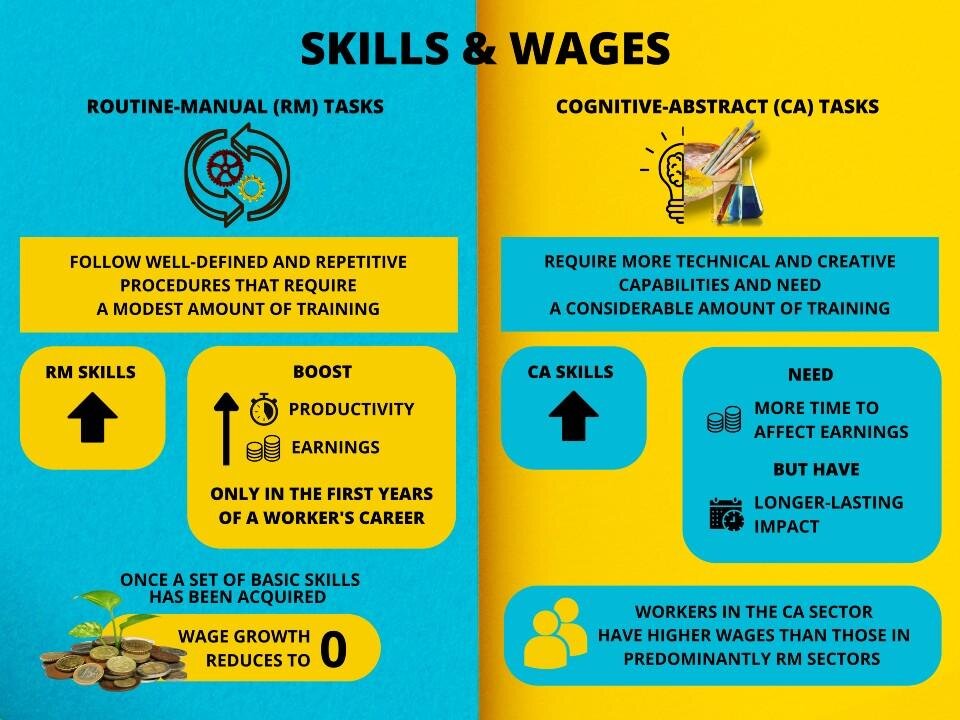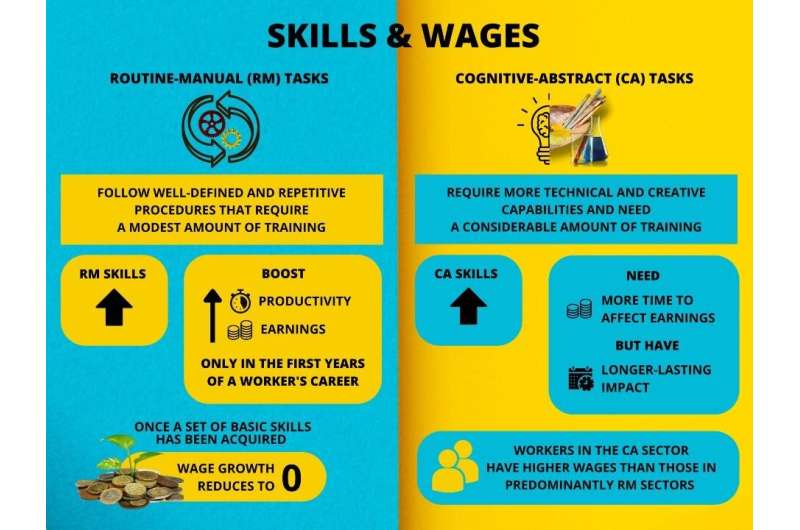

A new study by Jeroma Adda (Department of Economics) finds that the acquisition of skills is the main contributor to higher salaries for workers, with the magnitude of the effect differing according to the type of skill and the career stage of the worker. Although workers can acquire skills on the job, those who undergo training before entering the job market generally obtain greater wages and are in unemployment less often.
People make a series of choices throughout their careers: whether to get educated/trained before working, which job offers to accept, or whether they should quit their current job. Each decision has an impact on earnings that may unfold over many years, and understanding their effects requires not only examining immediate returns but longer-term outcomes. With this aim, Professor Adda and Christian Dustmann (University College London), in a forthcoming paper in the Journal of Political Economy, estimate a mathematical model to understand the determinants of wage growth. Using comprehensive data on labor market outcomes of German men over several decades, they find that workers’ ability levels, their accumulation of human capital, and changing of jobs across different sectors and firms all have significant positive contributions to earnings.
To unpack their findings, it is first important to understand that research on labor markets distinguishes the tasks workers perform into two categories: routine-manual (RM) tasks, which follow well-defined and repetitive procedures that require a modest amount of training; and cognitive-abstract (CA) tasks, which require more technical and creative capabilities. To estimate the returns for each type of skill, the authors classify each occupation according to the predominant type of task. Thus they are able to go beyond the differentiation of returns to different jobs and can estimate the returns to task-specific work experience. Their results indicate that the accumulation of RM and CA skills over the course of an individual’s career is the most important driver of wage growth. RM skills contribute more significantly to increases in worker productivity and earnings in the first years of their careers, but once a set of basic skills has been acquired their contribution to wage growth reduces to zero. On the other hand, CA skills take a longer time to be accumulated, and thus take longer to affect earnings, but have a longer-lasting impact, sustained throughout the individuals’ career. These differential returns translate to workers in the CA sector earning, on average, higher wages than those in predominantly RM sectors.
Such skills can also be accumulated through a training period that takes place before labor market entry, and the authors estimate the impact of undertaking such a program. When compared to untrained workers, trained individuals are able to accumulate more CA experience, which besides the direct wage benefits, also improves other aspects of job matching: trained workers become unemployed less often and receive competing job offers at a higher rate. This increased permanence in the labor market provides the opportunity to accumulate more experience, which in turn yields greater returns. Even when controlling for the difference in levels of innate ability of workers, the returns to training in apprenticeships remain positive and significant, both for the individual and society. Comparing outcomes of trained and untrained workers throughout their careers is essential, according to the authors, as focusing on immediate returns may lead to underestimation of the true benefits.
The authors also find that mobility of workers across the labor market contributes to higher salaries. Switching between different jobs generates a significant increase in earnings, but this is concentrated in the early years of the worker’s career, namely the first job move. Though this change produces large gains, these quickly decline and additional mobility does not seem to contribute to larger returns. However, the authors also observe the existence of lock-in effects: workers are initially allocated to a sector for which they are not the most suited, but the accumulation of experience specific to that sector disincentivizes them from moving to jobs in other sectors.
Thus, the authors provide a comprehensive overview of the variables that affect labor market outcomes, and their conclusions about the impact of training, experience, and mobility have important practical consequences. For workers, we learn the longer-term advantages of accumulating CA skills and the substantial returns individuals may obtain from undergoing training, which may not materialize immediately but have a significant impact later in their careers. For policymakers, we learn that returns to experience can generate inefficiency by locking workers into specific sectors, which may disproportionally affect workers who enter the job market during periods of restricted choices, such as recessions.
How sectoral employment training can advance economic mobility for workers who face barriers to employment
Jerome Adda et al, Sources of Wage Growth, Journal of Political Economy (2022). DOI: 10.1086/721657
Provided by
Bocconi University
Citation:
New skills are the high road to higher salaries, study finds (2022, August 3)
retrieved 3 August 2022
from https://phys.org/news/2022-08-skills-high-road-higher-salaries.html
This document is subject to copyright. Apart from any fair dealing for the purpose of private study or research, no
part may be reproduced without the written permission. The content is provided for information purposes only.

